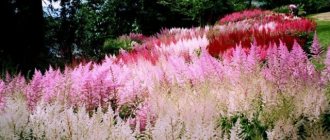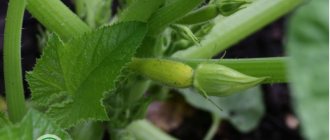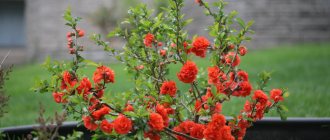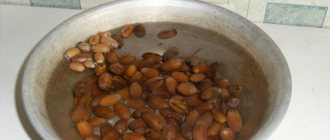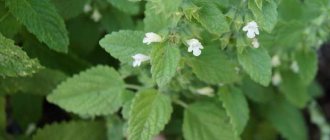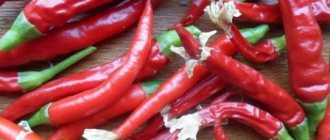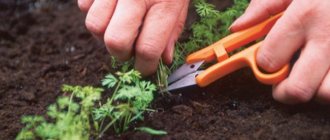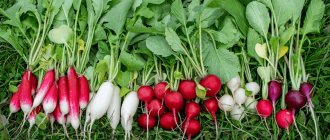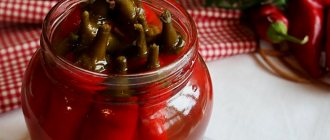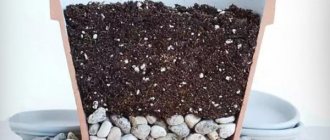Russian gardeners have recently begun to grow hot (bitter) peppers in open ground. Even 50 years ago, housewives tried to grow this exotic vegetable as a houseplant on their windowsills. The fruits were small, tasteless, and were sometimes used as a seasoning in cooking. Today in many gardens you can find this “guest” originally from America. Vegetable growers became interested in the varietal characteristics of a particular plant. They want to know how to properly plant and grow hot peppers. We will try to cover this topic together with experienced gardeners (see video).
Planting and caring for hot peppers
- Planting: sowing seeds for seedlings - in February-March in areas with a cold climate and in January-February in areas with a warm one. Seedlings are planted in open ground during the budding period, when the average daily temperature in the garden rises to 15-17˚C.
- Lighting: bright sunlight.
- Soil: light, permeable.
- Watering: frequent and plentiful, especially during flowering and fruiting: the soil on the site should not dry out. In hot weather, daily watering will be needed, and in drought, the beds will have to be watered twice a day.
- Fertilizing: at the beginning of the growing season, fertilizers containing phosphorus and magnesium are applied to the soil, and as the fruits ripen, the amount of nitrogen must be reduced.
- Reproduction: seed.
- Pests: aphids, spider mites, Colorado potato beetles, whiteflies, cutworms, thrips, mole crickets and naked slugs.
- Diseases: white, brown and black spot, black leg, tobacco mosaic, late blight, bacterial cancer, streak, gray, white and blossom end rot, verticillium, fusarium and downy mildew.
- Properties: the plant has medicinal properties.
Read more about growing hot peppers below.
Preparing seedlings
Hot peppers need light soil with moderate acidity. The ideal mixture consists of old garden soil, peat and washed sand . You can also use a purchased soil mixture to which humus has been added.
Peppers do not like dense soil; successful growth requires good drainage to prevent moisture stagnation.
Hot pepper seedlings: cultivation and care. Seeds should be sown in February. Before sowing, they are sorted, selecting empty and ugly ones. To speed up germination and strengthen the seeds, you can soak them in an aqueous solution of a growth stimulator for 10-12 hours. After this, the seed is washed and wrapped in wet gauze for swelling.
A spacious plastic or ceramic container is thoroughly washed and doused with boiling water. Drainage is laid at the bottom: broken shards, river pebbles or expanded clay. Soil is poured on top and watered abundantly with heated, settled water. When the soil has cooled, holes are made in it no more than 1.5 cm deep.
A seed is placed in each and sprinkled with soil. The container is covered with film and placed in a warm and well-lit place. Peppers can also be sown in peat pots placed on a deep tray.
Sprouts appear a week after sowing . They need to be carefully examined; weak ones can be removed so as not to interfere with the development of promising seedlings. With this approach, picking is not required. When the young plants reach 20 cm, the crown of each is carefully pinched to stimulate the development of side shoots.
Some gardeners prefer to sow hot peppers in the fall to get abundant fruiting in the spring.
The best option is to combine these methods, sowing seeds 2-3 times a year. Such a conveyor will help create a small garden of continuous fruiting and provide an opportunity to test new promising varieties.
Hot pepper - description
Red hot pepper is a shrub up to 60 cm high with branched and woody stems at the bottom. Its leaves are elliptical, petiolate, pointed towards the apex, the flowers are large, grayish with purple or white. Pepper fruits, trunk-shaped or spherical in shape, are berries with a low-juicy pericarp. The color of the fruit can be of different shades - from yellow or red to dark olive. Hot capsicum is a close relative of the tomato, so the rules and conditions for growing these crops are very similar.
Growing hot pepper seedlings
As soon as the shoots appear, the film is removed and the seedlings are placed in a bright place to avoid stretching the plants. On cloudy days, the sprouts are placed under fluorescent lamps for additional illumination. The optimal temperature for plant growth is +18+27 C.
Feed the seedlings after the third leaf appears. Urea and superphosphate are suitable for this purpose. Take 30 grams per bucket of water. superphosphate and 10 g. urea. The second feeding is carried out a couple of days before planting the peppers in the ground. Take 30 grams per bucket of water. potassium salt and 50 gr. superphosphate.
Growing hot peppers from seeds
Sowing chili pepper seeds
Growing hot peppers begins with sowing seeds for seedlings in February or March in cool regions and in January-February in warm regions. The soil mixture can be purchased at the store, or you can prepare it yourself: mix non-acidic high peat, humus and river sand in equal proportions. Hot pepper seeds also need to be prepared for sowing: first dip them in a weak solution of potassium permanganate for half an hour, then wrap them in a damp cloth and wait at a temperature of 25 ºC until they sprout. After this, the seeds, very carefully so as not to break off the sprouts that have appeared, are planted in moist soil to a depth of 5-10 mm, keeping a distance between them of at least 5 cm. Sow the seeds in boxes or peat pots, which are covered with film or glass and placed until shoots appear. to a warm place.
Growing pepper seedlings at home
Growing hot pepper seedlings
Seeds of different varieties of hot peppers germinate at different speeds, but as soon as shoots begin to appear, the crops need to be moved to light. If the plants lack lighting, a phytolamp or other lighting device should be placed above them at a height of 25-30 cm: daylight for normal development of seedlings must last at least 18 hours, otherwise the seedlings will stretch painfully. And do not forget to keep the substrate slightly moist, while at the same time not allowing it to become waterlogged. From time to time, it is advisable to loosen the soil between seedlings.
- How to transplant and propagate poinsettia
Hot pepper pick
At the stage of development of seedlings with two pairs of true leaves, it is necessary to pick the seedlings into shallow pots with a diameter of 8-10 cm - if you plant them in a deeper container, then by the time the seedlings are planted in open ground, the root system will be more developed than the fruitful ground part, and this it is advisable not to allow it. Before starting the procedure, the seedlings are watered. When picking, try not to damage the root system of the seedlings, but if the central root is too long, shorten it.
Before planting in the ground, hot pepper seedlings are fed twice - two weeks after picking and two weeks after the first feeding. Fertilizers are applied in the form of a solution of Krepysh, Agricola, Mortar, Fertika Lux or other suitable preparation.
Growing hot peppers at home
If you are going to grow peppers at home, when picking, transplant the seedlings into a pot in which a layer of drainage material is laid under the soil mixture. Place the pots of peppers on a south, south-east or south-west window sill, but if there is little light, provide artificial supplementary lighting for the plants. When the picked plants reach a height of 20 cm, pinch their tops to enhance tillering.
Caring for hot peppers at home includes regular watering and periodic feeding. Water the pepper with settled water at room temperature, which is poured not onto the surface of the soil, but into a tray under the pot. As soon as the water from the pan disappears, you need to add more.
During spring and summer, capsicums are fed with complex mineral fertilizer for house plants. This is done on damp soil after watering. When ventilating the room, make sure that the pepper is not in a draft.
When flowering begins, the pots of peppers need to be shaken slightly to allow pollination to occur. In winter, when heating devices operate intensively, it is advisable to cover radiators with a damp cloth - this measure prevents excessive drying of the air. A plant that is one year old needs to be replanted every spring into new soil and a larger pot.
Organizing the care of pepper bushes
Properly organized care of pepper plantings is an important condition for obtaining a voluminous harvest.
Watering
Hot pepper prefers moist soil. Lack of fluid can seriously affect the yield of certain varieties, the quality and shape of the fruit. However, immediately after planting the seedlings, you should not over-fill the holes - the roots of the seedlings may simply rot. It is better to gradually moisten the soil daily. It is enough to pour 100-150 ml of water under each bush. After a week, you can carry out regular watering.
In certain cases, the volume of water is increased: when buds and ovaries appear, hot, dry weather sets in. For irrigation, it is advisable to use warm water, which is poured under the root.
What and how to feed the plant
The first time fertilizing is applied 10-14 days after planting the seedlings, when the seedlings have taken root and can accept fertilizers. The type of feeding alternates:
- During the period of growth and formation of greenery, nitrogenous compounds are used (a mixture of 5 g of superphosphate and 10 g of urea is diluted in 10 liters of water). Approximately 0.7-1 liters of solution is poured under the seedling;
- when the first buds appear, mixtures with potassium are used (a teaspoon of potassium and urea, 20 g of superphosphate are diluted in a 10-liter bucket of water);
- During fruiting, the bushes are watered with a solution of superphosphate and potassium salt (take 2 tablespoons of each element per 10 liters of water).
Expert opinion
Stanislav Pavlovich
Gardener with 17 years of experience and our expert
Ask a Question
Important! When watering plants, fertilizers should not fall on the foliage.
Loosening and mulching the soil
Properly carried out measures can reduce the frequency and volume of watering and prevent the growth of weeds.
Mulch wet beds, cleared of weeds. If a crust has formed on the soil, it should be loosened. Thanks to loosening, soil drying slows down and the soil is saturated with oxygen. Then the ground is watered and covered with mulch.
The thickness of the mulch layer is determined by the type of soil. Light soil can be covered with a layer of mulch 5-10 cm thick. In beds with heavy clay soil, mulch is laid in a thin layer - 2-3 cm.
The mulch is laid out so that it does not come into contact with the plants. The optimal distance to the stem of hot pepper is 2-3 cm. The easiest way is to use hay and straw as mulch (the beds should not be covered with dried weeds).
See also: What and how to feed pepper seedlings for growth
Treatment against insects and pests
Most varieties of hot peppers are resistant to diseases and pests. Common diseases that can affect plants:
- fusarium;
- late blight;
- powdery mildew;
- tobacco mosaic virus.
To combat diseases, pepper plantings are sprayed with antifungal drugs. Most often, gardeners use the fungicides Previkur and Antrakol.
Possible pests that affect hot pepper bushes: spider mites, whiteflies, aphids. The main pest control measures are spraying plants with solutions of Provanto Mite and Actellik insecticides.
Shaping and garter
As the pepper grows, the stems become elongated. To reduce the load from the fruit on the trunk, each bush is tied to a support. A small stick is stuck into the ground and the stem is tied to it with ropes in several places.
Experienced gardeners recommend forming a pepper bush with 2-3 stems. After the formation of a fork on the stem, the first bud must be removed. With further growth, the stepsons, all leaves and flowers located below the fork are cut out. As soon as 25-30 fruits are formed on the bush, the tops of the stems are pinched and new ovaries are removed. This ensures the ripening of high-quality fruits.
Planting hot peppers in open ground
When to plant hot peppers in the ground
Planting hot peppers in open ground is carried out at the stage of formation of the first buds of the seedlings. A prerequisite is also to set the average daily temperature at 15-17 ºC.
Growing sweet peppers from seeds - planting and care
Two weeks before planting, hot pepper seedlings undergo hardening, which involves daily “walking” the seedlings in the open air. You need to start with 15-20 minutes, but gradually increase the duration of the session until young plants can spend the whole day in the air. Once the plants have become accustomed to the environment in which they will grow, they can be planted in the garden bed.
Ground for chili peppers
Neither bitter nor sweet peppers can withstand heavy cold soils, so peat and humus must be added to the clay soil before digging to the depth of a spade bayonet. If your soil is light and permeable, fertilize it in the fall with rotted manure at the rate of 2 buckets of organic matter per m² of land. Although you can apply fertilizer directly to the hole when planting seedlings.
How to plant hot peppers in open ground
Make holes in the soil at a distance of 30-40 cm with row spacing of 60 cm. You can plant peppers in a nesting manner, according to a 50x50 cm pattern, placing two seedlings in one hole. The depth of the hole should be such that the seedling is immersed in it up to the root collar. Place a tablespoon of complete mineral fertilizer in each hole, mix it well with the soil, carefully remove the seedling with the earthen lump from the pot and transfer it to the hole. Fill the hole halfway or a little more with soil, pour a third of a bucket of water into it, and when it is absorbed, fill the hole to the top with soil. After planting, mulch the bed with peat and, if necessary, tie the bushes to supports. If the air temperature at night is below 13-14 ºC, cover the bed with peppers with non-woven material, throwing it over the dug arches. Seedlings should be planted on a cloudy day or in the late afternoon, after sunset.
Growing chili peppers in a greenhouse
Experts say that chili peppers grow much better in a greenhouse than in open ground. This can be explained by the fact that in closed ground conditions it is easier to control the temperature regime, and the level of air humidity in the greenhouse is more stable than in the garden. Pepper seedlings are planted in closed ground when the seedlings reach a height of 10-15 cm and night temperatures reach 10-12 ºC. Before planting, the seedlings are hardened off in the manner we have already described.
The optimal daytime temperature for the growth of chili peppers in a greenhouse is 16-18 ºC. In a heated greenhouse, plants are watered often, but not abundantly; in an unheated greenhouse, in cool weather, watering of plants is reduced. Moisten the soil with warm water. After watering, do not forget to loosen the soil around the bushes and remove weeds. From the moment the fruits form, the plants are fed once a week with liquid fertilizer for tomatoes. Bushes of tall varieties are tied to supports. If at the end of summer the ripening of fruits begins to slow down, hang the bushes pulled out of the soil on the eaves of the greenhouse “upside down” - this measure will speed up ripening.
Keep in mind that it is better to grow self-pollinating varieties indoors, but if you planted peppers that require pollinators, you will have to do this yourself. To do this, you'll need a soft pollen brush or a fan, but sometimes shaking the plants is all you need.
- Cabbage plants: fruit and ornamental
The last harvest of fruits is carried out before the onset of severe frosts, after which the bushes are transplanted into flowerpots and transferred to a heated room on the windowsills. With the onset of spring, they can again be planted in a greenhouse or open ground.
Features of crop rotation when growing hot peppers
If you follow the rules for crop rotation, you can preserve nutrients in the soil, preventing its depletion. Nightshades consume a large amount of vitamins and minerals, after which it is necessary to plant certain plants:
- beans;
- beans;
- peas
The crops have a specific aroma that repels parasitic insects. What can you plant hot peppers with every year: with legumes, which actively enrich the soil with nitrogen during development.
Important! Sweet peppers are not planted nearby - mutual pollination will provoke a change in the taste qualities of both crops.
Caring for hot peppers in open ground
How to grow hot peppers
When the seedlings reach a height of 30-35 cm, their tops are pinched off. After this, the bushes acquire a compact shape, side shoots appear on them, which will also bear fruit. If you want to grow large peppers, remove several flowers from the bush, then the remaining fruits will be larger. The optimal number of fruits on a bush is 25 pieces; it is better to remove the rest. At air temperatures above 30 ºC, bitter pepper stops pollination, and in order for it to still occur, the bushes should be slightly shaken. By the way, do not plant bell peppers next to hot chili: these crops easily cross-pollinate with each other, so the distance between them should be at least 3.5 m.
Watering chili peppers
Pepper is a moisture-loving crop and especially needs moisture during the flowering and fruiting period. Do not allow the soil in the garden bed to dry out too much. Be prepared to water your peppers daily in the summer, or even twice a day in extreme heat. Water for irrigation should be warm. To do this, place a large container in the garden in bright sunshine and fill it with water. During the day, the water can settle and warm up. After watering, you can loosen the soil between the plants and remove weeds.
Feeding hot peppers
At the beginning of the growing season, chili peppers need phosphorus and magnesium, and before the fruits ripen, the amount of nitrogen fertilizer applied must be reduced. In general, feed hot peppers with the same fertilizers as tomatoes, and at the same time.
Choosing a variety for home and greenhouse
This is a perennial plant with a compact bush, decorative foliage and bright fruits. Peppers can be grown in an apartment or greenhouse. Some varieties are also suitable for open ground.
Breeders have developed many varieties that differ in flavor nuances and fruit size, yield, and ripening speed. At home, varieties and hybrids of Dutch, Polish or Russian selection are often grown .
Hot pepper varieties for growing at home:
Little Miracle is a Dutch variety suitable for home cultivation. Fruits abundantly, the fruits are small, orange, red or yellow. The taste is sharp but delicate, ideal for sauces.
Red fat man is a variety of Russian selection. The rather tall bush is abundantly covered with large cone-shaped fruits, suitable for canning. Can be grown both in a greenhouse and in open ground.
Astrakhan is a Russian variety characterized by high yield. Compact bushes produce many small, elongated, bright red fruits with an unusually pungent taste. Used to prepare tinctures and sauces.
Ukrainian acute is a small bush that grows well in a greenhouse or pot. The fruits are very long and thin, with a spicy, burning taste.
Flame is a medium-fruiting, productive variety. The fruits are bright red, elongated, very juicy. Widely used in cooking. Greenhouse cultivation is preferred.
Jalapeño , a popular hot pepper in Latin American cooking, has small red or green fruits. The taste is moderately spicy, recognizable. The fruits are well stored, the variety is quite productive.
After choosing a variety, we will describe how to grow hot pepper from seeds at home?
Pests and diseases of hot pepper
The most dangerous pests for nightshade crops are aphids, spider mites, Colorado potato beetles, whiteflies, cutworms, thrips, mole crickets and naked slugs. However, pepper is a more resilient plant than tomato, so it is not damaged by insects so often.
Among the diseases, hot peppers are affected by the same ailments that affect tomatoes and eggplants: white, brown and black spot, black leg, tobacco mosaic, late blight, bacterial cancer, streak, gray, white and blossom end rot, verticillosis, fusarium and downy mildew.
Chili Pepper Processing
We have talked about all these pests and diseases more than once, so we will not describe them again - you can find information about them in the articles on growing tomatoes, eggplants and sweet peppers posted on the site. Let us briefly recall that fungal diseases in emergency cases are treated with fungicidal drugs, among which the most often used are Abiga-Pik, Bayleton, Bordeaux mixture, Gamair, Maxim, copper sulfate, Oxychom and others, but bacterial and viral diseases are incurable. As for pest control, the best insecticidal and acaricidal preparations are Agravertin, Akarin, Actellik, Karbofos, Karate, Kleschevit and others.
However, the use of pesticides can lead to disastrous consequences for your health, so try to get rid of problems using folk remedies - although they do not act so radically, they are much less harmful to health. And if you follow the agrotechnical conditions of the crop and properly care for it, you can reduce the risk of plant disease or pest invasion to a minimum.
Pepper for open ground: which variety to choose
To choose the right variety for growing, it is important to consider a number of factors. Of particular importance are:
- Maturation period. The growing season of most varieties lasts for 4-5 months, and for the full development of plants during this time a comfortable temperature is required. Before planting, you should find out in advance the duration of the warm period, and taking into account the average temperature, select a variety with early or late ripening.
- Resistance to external factors. When growing peppers, you may encounter sudden temperature changes, pest invasions and diseases. To simplify daily care and not lose the harvest, you should give preference to varieties with increased immunity and protective properties.
- Taste characteristics. Depending on your own preferences, you need to select a variety of pepper with a suitable degree of bitterness. Different varieties range from low- to high-burning in the presence of capsaicin, which affects the pungency of taste.
Collection and storage of hot peppers
Red hot peppers can be used either at the partial ripe stage or after they are fully ripe, so they can be harvested as soon as the fruits are formed if necessary. If you plan to store the pepper for long-term storage, then wait until it is completely biologically ripened, otherwise it will not be stored well: the storage duration of red hot pepper depends on a special substance, the amount of which in the fruit increases as they ripen. That is, the riper the fruit, the more bitter substances it contains, which manifest themselves as preservatives during storage.
Red hot pepper has pronounced signs of ripening:
- the pods should turn red, yellow or orange;
- pepper leaves turn yellow and dry on the lower part of the bush;
- If you rub pepper on your hand, a slight burning sensation comes from the ripe fruit.
Typically, chili peppers begin to be harvested at the end of September. Preparing it for storage is very simple: dip the pepper in a bowl of warm water for a few minutes, wash it from dust and dirt, rinse with cold water, wipe with a towel and dry.
There are different ways to store hot peppers - the method you choose depends on how you intend to use them. You can store chili fruits by hanging them by the stalk on a rope - you can decorate your kitchen with such a garland. It is important that the peppers do not touch each other. Well-dried fruits are placed in bags made of thick fabric or in glass jars, covered with parchment and stored in a dry place. You can dry peppers by laying them on a windowsill on parchment paper - with regular turning, the fruits dry in three weeks, but if you want to speed up the process, cut the peppers in half.
You can grind the pepper in a meat grinder, put the mixture on a baking sheet and dry it in the oven at a temperature of 50 ºC. When the pepper has cooled, place it in a bag. Some housewives dry the peppers for a couple of hours in the oven at a temperature of 50 ºC, first covering a baking sheet with paper and turning the peppers over from time to time.
Many housewives prefer to preserve peppers in sunflower oil. To do this, place washed and seeded peppercorns in a sterile glass jar, fill them with sunflower oil, lightly add salt to it, roll up the jars with a sterile lid and store in a dry, dark place for 2-3 months.
- Zygopetalum at home: care and types
Peppers can also be preserved in marinade. Whole or sliced fruits, from which the seeds have been removed, are placed in sterile jars, poured with a sour-sweet marinade and sealed with sterile lids. You can add your favorite spices to each jar - cherry or currant leaves, garlic, basil, cloves. For normal storage, one teaspoon of vinegar per liter jar is enough.
Salted pepper has an excellent taste: put dill, celery, a few cloves of garlic in a jar with pepper and fill with brine (50-60 g of salt per 1 liter of water). You need to store salted peppers under a nylon lid in the refrigerator or cool cellar.
There is another method that will seem simple and reliable to you: hot peppers are placed in the freezer, where they do not change their color, attractive appearance, do not wrinkle, and most importantly, retain all their valuable qualities. The red pepper fruits are washed in cold water, blotted with a towel, placed in bags, sealed tightly and placed in the freezer. You can also freeze chopped fruits. They are laid out in one layer on a pallet, frozen, then transferred to plastic bags and put back in the freezer for storage.
Sowing seeds for seedlings
You can grow peppers from seedlings at home. When should the seeds be planted?
The best time is mid-February when daylight hours increase. Red peppers are very delicate and love the light. The productivity depends on the number of seeds, it can be a small pot or a box.
Seeds can be stimulated to germinate faster using the following products. Heat the plant material, place the seeds in water at 40°C and seal in a thermos flask for 3 hours.
The second method is soaking in warm water for 12-24 hours. Oxygen is supplied to a water cylinder.
Please note: You must ensure that shooting is not tight. In the first week after the leaflets are published, the air temperature drops to 20°C and the lighting increases. If more than 3 leaves appear, seedlings can be collected. The hotel has a spacious potty.
The first seedlings appear in 7-10 days. The pan should have as much sunlight as possible and the room should be warm. The strongest shoot is selected for further processing, the rest is removed (without damaging the roots).
Types and varieties of hot peppers
There are more than 3000 cultivated varieties and varieties of chili. The classification of hot pepper varieties takes into account such characteristics as color, aroma, shape and degree of hotness, which is determined according to the scale of the American chemist Wilbur Scoville and is assessed in ESH (a unit of the Scoville scale). The unit of heat measurement indicates the amount of the alkaloid capsaicin in a particular plant variety. We offer you an introduction to the most popular varieties and varieties of hot peppers:
Trinidad pepper
– this family is distinguished by its pleasant pungency, original appearance of fruits and persistent fruity aroma. Varieties:
- Trinidad Small Cherry (160,000 ECU) – the fruits of plants in this series look like orange or red round berries with a diameter of no more than 2.5 cm with a characteristic cherry aroma. Of greatest interest are the late-ripening varieties of the Moruga Scorpio Red and Moruga Scorpio Yellow series.
- Trinidad Scorpion (855,000-1,463,700 ESH) – These small, bright yellow peppers are grown to produce tear gas and paint to protect ships from shellfish growth. They are so hot that they collect and process these peppers while wearing hazmat suits;
- Family 7 Pot - this series is represented mainly by late-ripening chili varieties. The fruits of these varieties are distinguished by their unusual, crumpled shape, characteristic fruity aroma and high content of capsaicin. These are close relatives of the Trinidad scorpion. Of the varieties, the most popular are the record holder for the pungency of taste, Primo (800,000-1,000,000 ECU) with bright red fruits, and Gigantik, a variety with very large fruits of the same pungency.
Naga Jolokia (970,000-1,001,304 ECU)
– This pepper is grown by the Naga tribe of India and is used to make pepper smoke bombs. But there are also edible varieties of this group:
- Naga Morich, or Dorset Naga (1,000,000 ECU) – a variety for gastromasochists;
- Bhut Jolokia (800,000-1,001,304 ECU) is until recently the hottest pepper in the world, listed in the Guinness Book of Records, but in 2013 it lost the championship to the Carolina Reaper variety (1,569,300-2,200,000 ECU). Bhut Jolokia pepper is used to make grenades used by the Indian police;
- Bhut Jolokia Chocolate is the same hot pepper, but Indians cook some varieties of curry with it.
Habanero (350,000-570,000 ECU)
– lantern-shaped peppers, usually bright orange. There are legends about this pepper: allegedly, once upon a time the Indians of Yucatan offered a person a choice: to be sacrificed to the gods or to drink half a liter of tincture of this pepper, and many chose the first. Today, Habanero peppers are used to make Tabasco sauce and add heat to tequila. Of particular interest are:
- White habanero (100,000-350,000 ECU) – a variety with small white fruits. However, it is not easy to grow, which is why it is rare;
- Chocolate habanero, or Congo Black (300,000-425,000 ECU) - a variety grown from Mexico to Jamaica for the preparation of hot sauces;
- Red Caribbean habanero (300,000-475,000) - Mexicans use the fruits of this pepper for salsa and other sauces.
Jamaican pepper (100,000-200,000 ECU)
- aromatic, but dangerous for humans, pepper that can cause burns. In terms of pungency, this group of varieties is close to Habanero. The varieties Jamaican Red and Jamaican Yellow are popular in cultivation. Jamaican pepper is used to prepare sauces; it is also added to pickles, marinades, meat and dairy dishes. The hottest variety of Jamaican pepper:
- Scotch cap, or Scotch Bonnet (100,000-350,000 ECU) – this pepper can most often be found in the Canary Islands, Guyana. The Scottish cap can be red or yellow. The pepper got its name from the resemblance of the fruit to the Scottish beret. The pungency of this pepper causes numbness in the limbs and dizziness. It is used to prepare sauces and first courses, and some gourmets like to enjoy its fruits with fruits and chocolate;
Thai pepper (75,000-150,000 ESH)
– this pepper is native to Portugal, but it is grown mainly in Thailand. Thai varieties of hot pepper are used to prepare fish and meat dishes, sauces, salads, and also to get rid of cellulite. The most famous variety in our latitudes:
- Thai dragon is a variety with red or yellow fruits up to 7 cm in length and up to 8 mm in diameter. Widely used in Vietnamese, Malaysian, Filipino and Thai cuisine.
Cayenne pepper (30,000-50,000 ESH)
– the name of pepper comes from the toponym of a port city in French Guiana, through which spices from South America were transported to Europe from the 15th to the 19th centuries. This group includes Malaga peppers, Tabasco and Tiri Tiri peppers, Malawian Kambuzi peppers and all Thai peppers. Varieties of cayenne pepper are used to prepare canned food, sausages, and marinades. It is also used for medical purposes to treat radiculitis. Cayenne pepper is one of the most popular varieties in amateur gardening;
Serrano (10,000-23,000 ECU)
– in Mexico, this pepper is called a time bomb, since its heat does not appear immediately;
Hungarian wax pepper (5,000-10,000 ESH)
– this pepper with large yellowish fruits is called mildly hot and is used for stuffing and pickling in rings;
Poblano (1,000-1,500 ECU)
- the main pepper of Mexico, the mildest of all described. Its large, elongated green fruits with a thick skin taste like prunes and are traditionally prepared on Independence Day when stewed with white nut sauce and pomegranate seeds. It is stuffed with cream cheese, seafood, pork, potatoes, beans and other foods.
Among gardeners in the middle zone, the following varieties of red hot pepper are popular: Jalapeño, Thai Dragon, Astrakhan, Chinese Fire, Kiss of Satan, Indian Elephant, Shishito, Peter, Spicy Tongue, Anaheim, hybrids Spicy Bell, Double Abundance, New Year's Octopus, Flying Moth and other.
Bitter pepper: description of varieties, cultivation, care and photos
Hot peppers can be grown with great success not only in the garden, but also at home, in pots. As a result, you will get a delicious spice and a beautiful ornamental plant. Today there are many different types of indoor varieties on sale; we will look at the most delicious and beautiful varieties of hot peppers for growing on a windowsill.
Benefit or harm
Hot pepper normalizes blood circulation. Prevents the development of vascular diseases, Parkinson's disease and Alzheimer's disease. Useful for prevention:
- reduces cholesterol levels;
Application in medicine
Most often, hot pepper is used in medicine:
- Dried and ground fruits are used to make sticky peppers. It is used as a skin irritant for bloodletting - for colds, muscle and joint pain, rheumatic pain and arthritis. It simply sticks to the sore spot and stays on for a few days - it acts as a warming agent and works very well.
- In Eastern medicine, ointments from it are rubbed into the skin with some inflammatory diseases and the flu - this prevents complications after them.
- It is an excellent laudable and antipyretic. It is mixed with honey 1:1 and taken on a teaspoon 3-4 times a day, or with milk.
- A piece of red pepper is placed under the tongue or allowed to be sniffed when fainting.
- If your feet are very cold, wear a pepper bandage on your feet.
For nails
Masks with red pepper accelerate nail growth and strengthen nail plates. The nails from these masks become healthier. In this case, the mask treats nails and prevents the development of fungi.
They can be done on both hands and feet.
For hair
When the hair gets into the roots, rub diluted pepper tincture - this causes a rush of blood to the roots, and this strengthens them. The hair from this procedure is better and more likely to grow.
These masks cannot be used more than 2 times a week - for 15-20 minutes, both for nails and hair.
Anti-cellulite drug
Red pepper extract is added to the cream, which is rubbed into the body against cellulite. Capsaicin contained in red pepper promotes the resorption of adipose tissue. If such a cream is simply applied to the palms or feet before going out into the cold, they will not freeze for a long time.
Harm
It is very caustic, you must be careful when cleaning - its essential oils in high concentrations can irritate the mucous membranes and even the eyes. In difficult cases, even a burn. It is also necessary to protect your hands when peeling peppers - cellulose can irritate the skin. It is better to work with gloves and not touch your eyes.
Do you think it’s worth eating hot pepper regularly?
Hot pepper seeds
We present to your attention some varieties of hot pepper.
Bell
These fruits have the original shape of a bell-shaped flower. Upon reaching biological maturity, they acquire a scarlet color. They are distinguished by a combined taste: the “petals” are sweet, but the spiciness is felt closer to the heart. Spicy seasoning for meat dishes.
Fire Dragon
Middle-aged, versatile variety of hot peppers. Cultivated in open areas and in film greenhouses. Forms a powerful, branched shrub up to a meter high. The fruits are long up to 10-12 centimeters, slightly flattened with a wall thickness of up to 0.8 millimeters and weighing up to 20 grams.
Shakira
Hybrid pepper Shakira F1 has a high yield. The fruits ripen at the end of the second month after the seedlings are planted in the soil. The plant is an open type.
The fruits are uniform, with a glossy sheen, with a pungent taste, 3-4 cm in diameter and 16 to 18 cm long, dark green at technical maturity and dark red at biological maturity.
Cultivated in open soil and in film greenhouses. This plant is resistant to tobacco mosaic virus 0-2.
Tsitsak
Medium ripening variety. The maximum height of the bush is 60 cm. Heat-loving and therefore in cool areas it is better to grow under a film. The fruits have a conical shape, quite long - 15-20 cm. The color of unripe fruits is light green, when fully ripe - red. The flesh is fleshy. The taste is quite sharp with a pronounced sweet note.
Nosegay
Belongs to the most compact varieties. The bush grows to a height of 15 cm; the round pepper also has a miniature size. As it ripens, the color changes several times: first green, then cream, yellow and finally red. For this purpose, a plant with round fruits is enough for a small one-liter pot. Peppers with moderate heat.
Rowanushka
One of the most decorative varieties. The leaves have an unusual shape, resembling a boat, with the edges curled inside. The peppers are round, small, and resemble rowan berries. The fruits are placed inside the leaves.
Indian summer
The plant grows well in the shade and does not require special care. Forms a compact three-dimensional bush with small leaves. Flowers in white or inky shades. Peppers grow in different shapes and colors and have a distinct pungency.
Habanero red
This variety produces very hot fruits and a high yield. The shape of peppers resembles physics. They reach a size of 4 cm, have a ribbed skin, and have a pleasant fruity aroma. The weight of one fruit is 15 g. The bush requires abundant watering.
The Habanero pepper is native to Mexico. This vegetable is one of the hottest peppers, and the vegetable also has several types. In this article you can learn about the characteristics of other types of Habanero peppers.
Rainbow
The variety bears small round fruits and looks decorative. The tip is slightly elongated. The fruits change color as they ripen, so multi-colored peppers appear in the bushes at the same time.
Confetti
This variety is characterized by a beautiful small shrub - up to 40 cm. It belongs to the late pepper, loves warmth and light, and abundant watering is necessary for the plant. Fruits of different colors grow on the bushes at the same time; they reach 7 cm in length. The yield is very high.
Growing hot peppers and care
Before planting, it is necessary to prepare nutritious soil with the addition of compost and humus. In addition, it is desirable to have river sand, leaf soil and loose top peat. The seeds are sown scattered and then sprinkled with a small layer of sifted soil.
Indoor plant
The first shoots usually appear already on the 15th day. Be sure to pinch the arrowhead to prevent the plant from stretching. As for harvesting, it is usually carried out 30 days after planting the seeds.
Indoor peppers, the care of which includes the introduction of organic fertilizers, need good lighting and regular feeding with a weak solution of flour and chicken manure.
The pepper blooms in small white flowers, which gives it a decorative, showy appearance. Do not forget about abundant watering and loosening the soil.
Please note that the pepper is tied without artificial pollination. After harvesting indoor pepper, so-called rejuvenation is required. To do this, it must be transplanted to new soil without damaging the root system.
Source: https://prodachnika.com/ogorod/pertsy/gorkij-perets.html
Properties of hot pepper
Useful properties of hot pepper
What are the benefits of chili pepper? The composition of red hot pepper includes:
- vitamins: A, B1, B2, B5, B6, B9, PP, K, E, C;
- macro- and microelements: potassium, iron, magnesium, manganese, copper, calcium, sodium, zinc, selenium, phosphorus and others, but in smaller quantities, as well as dietary fiber, proteins, fats, carbohydrates, saturated fatty acids, mono- and disaccharides, wax, dyes and the most valuable alkaloid capsaicin.
What is the effect of hot pepper on the human body? It is a good remedy for stimulating appetite and, having a bacterial effect, relieves intestinal disorders, and as an external remedy it is used for myositis, rheumatism, polyarthritis, gout, and catarrh of the upper respiratory tract. Chili pepper is useful for its strong antioxidant effect; it stimulates the metabolic process, activating the burning of calories. Hot pepper improves immunity, strengthening the body's resistance to colds, viral and bacterial diseases, thinning the blood, reduces the risk of cardiovascular diseases, tones the nervous system and increases potency. Red pepper is used to treat diseases such as bronchitis and other bronchopulmonary diseases, vitiligo and panaritium. Chili peppers promote the production of endorphins, which increase pain tolerance and resistance to stress, and recent studies have shown that they are effective in treating some complications of diabetes.
Harm of hot pepper - contraindications
The use of hot pepper is contraindicated for people suffering from diseases of the gastrointestinal tract - gastritis, duodenitis, ulcers, liver and kidney diseases. It is not recommended for patients with angina pectoris, arrhythmia and hypertension. Hot pepper and preparations made from it can cause skin irritation, and they are especially dangerous if they come into contact with the eyes, so do not forget to wash your hands after touching them. If you accidentally eat hot pepper, it is useless to wash it down with water; in this case, it is better to drink milk or yogurt. A couple of sips of fresh lemon juice may help relieve the burning sensation.
Useful tips
- You can grow hot peppers if you listen to the recommendations of experienced gardeners. It is advisable to follow these steps to ensure good growth and yield.
- It is important to feed the crop with the right fertilizers. Before flowering, nitrogen-containing preparations are added to the soil. After the flowers appear, they are fed with phosphorus and potassium supplements.
- A feature of simultaneous planting of sweet and bitter peppers in one area is cross-pollination. So, if you plant two crops side by side, the fruits of sweet peppers will taste bitter. To avoid this, crops are planted farther away. Additionally, other plants are planted between the beds. You can also plant sweet and bitter peppers on different sides of the house.
- Cultivation rules dictate that hardened peppers should be harvested, not soft ones. The soft-textured fruits are unripe and are harvested for growing hot peppers, not for consumption.
- Chili peppers should be picked together with the stalk. Then they need to be stored in a dry place at a temperature of about 20 degrees. Then the pepper will ripen and its taste will improve significantly.
If you follow the above tips, you can both grow hot peppers for yourself and for sale, because the rules will allow you to avoid annoying mistakes that lead to loss of harvest.
Botanical description
Pepper (Capsicum annuum L.) is an annual plant belonging to the nightshade family. The shape, color, and size of the fruit are varietal characteristics. Pepper is native to Central and South America, where it was grown long before Columbus's expeditions.
| Characteristic | Photo |
| Root system. The root is a taproot (after picking the seedlings it becomes fibrous), grows to a depth of up to 90 cm. Like a tomato, numerous lateral roots are formed, growing up to 40 cm in diameter. On the main root, at the root collar covered with soil, adventitious roots may appear. Pepper is sensitive to damage to the root system and does not regenerate underground parts well. | |
| Stem. The main stem is straight, rigid, grows up to 60-80 cm - depending on the variety. Branches at the top. In some cases, branching may occur at the base of the shoot. At a later stage, the main shoot becomes woody. | |
| Flowers. Peppers are self-pollinating. Small, white flowers form on the shoots, in the corners of the leaves. |
